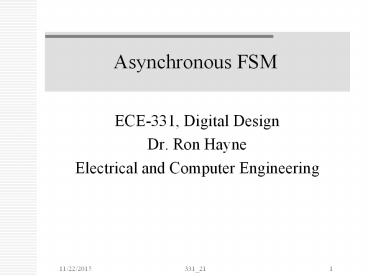Asynchronous FSM - PowerPoint PPT Presentation
1 / 29
Title:
Asynchronous FSM
Description:
All internal state changes occur in response to a single edge or level of the clock ... An output change does not depend on the simultaneous change of more than ... – PowerPoint PPT presentation
Number of Views:172
Avg rating:3.0/5.0
Title: Asynchronous FSM
1
Asynchronous FSM
- ECE-331, Digital Design
- Dr. Ron Hayne
- Electrical and Computer Engineering
2
Synchronous FSM Assumptions
- Single-Clock Property
- There is one, distinguished input called the
clock - Output changes and state changes occur only in
response to the clock input - No input other than the clock directly affects
the output - Single Edge Property
- All internal state changes occur in response to a
single edge or level of the clock
3
Asynchronous FSM
- Fundamental Mode Assumption
- An output change does not depend on the
simultaneous change of more than one input - Fundamental Mode Operation
- Only one input is allowed to change at a time
- FSM is allowed to settle to a stable state before
a next input is allowed to change
4
Asynchronous FSM
Input
Next State Variables
Present State Variables
Feedback
5
Asynch. Design Difficulties
- Delay in Feedback Path
- Not reproducible from implementation to
implementation - Variable
- may be temperature or electrical parameter
dependent within the same device - Analog
- not known exactly
6
Asynch. FSM Benefits
- Fastest FSM
- Economical
- No need for clock generator
- Output Changes When Signals Change, Not When
Clock Occurs - Data Can Be Passed Between Two Circuits Which Are
Not Synchronized
7
Analysis of Asynch. FSM, e.g.
Input
Next State
y1
Present State
y2
8
Next State Variables
9
K-Map of NS Variables
10
Transition Table
NS Y1Y2
grey code
11
Stable State
- PS NS Stability
- Machine may pass through none or more
intermediate states on the way to a stable state - Desired behavior since only time delay separates
PS from NS - Oscillation
- Machine never stabilizes in a single state
12
Stable States
NS Y1Y2
13
State Diagram
0
0
00
01
0
1
1
1
Oscillation
10
11
1
0
14
Races
- A Race Occurs in a Transition From One State to
the Next When More Than One Next State Variables
Changes in Response to a Change in an Input - Slight Environment Differences Can Cause
Different State Transitions to Occur - Supply voltage
- Temperature, etc.
15
Races
PS
01
10
desired NS
16
Types of Races
- Non-Critical
- Machine stabilizes in desired state, but may
transition through other states on the way - Critical
- Machine does not stabilize in the desired state
17
Critical vs Non-Critical Races
PS
01
10
18
Analysis of Transition Table
- Starting From Each Stable State, Determine If a
Change in Any Input Variable Causes a Change in
More Than One State Variable
19
Normal State Transition
Assume PS00
20
Normal State Transition
- Input Variable Changed From 0 to 1
- PS Changed From 00 to 10
- Only one state variable changed, so no race
- 10 Turned Out to Be a Stable State When Input
Equals 1 - No other states transited on way to stable state
- Note that input determines column in which to
find PSNS
21
Race Transition
Assume PS10
22
Race Analysis
PS
10
01
23
Another Example
24
Stable States
PS NS Stability
25
Identify Races
26
Race Analysis (1)
11
critical
00
27
Race Analysis (2)
10
01
28
Cycles to Avoid Races
29
End of Lecture
- Asynchronous FSM
- Fundamental Mode Assumption
- Analysis of Async FSM
- Stable States
- Normal Transition
- Races

